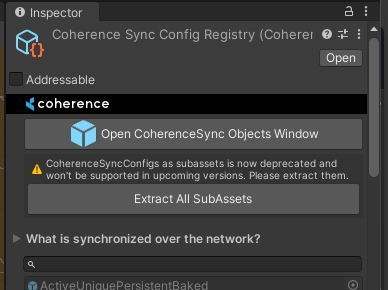Upgrade 1.1 -> 1.2
Before upgrading, back up your project to avoid any data loss.
APIs marked as depracted on 1.0 and earlier are removed on 1.2. Make sure your project is not using them before upgrading.
Sample UI
coherence / Explore Samples / Connection Dialog(s)
CoherenceSyncConfigManager
Source Generator baking strategy
Falls back to Assets baking strategy
Major changes for CoherenceSyncConfigRegistry
There has been a major refactor on how we deal with the registry.
First off, we're deprecating the registry holding configs as sub-assets.
This has been the default up to 1.1, but on 1.2, it has been changed to store the configs in the
📁 Assets/coherence/CoherenceSyncConfigs folder.
For 1.2, we have avoided manual migration of existing sub-assets. You can trigger this operation from the registry inspector (Assets/coherence/CoherenceSyncRegistry). We don't automate this operation, since the extraction changes the asset GUIDs of the configs, which could lead to missing references. This is specially true if your project is referencing the configs directly, instead of going through the registry. Keep this in mind when you decide to extract existing sub-assets.

It is important that you perform the forementioned migration as soon as possible, since SDK will be deprecating reading from sub-assets in upcoming releases.
The APIs provided have changed too. Check CoherenceSyncConfigRegistry, CoherenceSyncConfigUtils and CoherenceSyncUtils. Exposed functionality has been documented.
Compilation Errors
When the package imports, if there are any compilation errors, Unity won't do a domain reload. This means the previous package is still in memory and executing, but the contents of the package (might) have changed drastically. This can yield numerous errors and warnings on the Console, that will fade away once the compilation (followed by a domain reload) is completed.
If, after compilation, you are still experiencing issues using the SDK (errors hitting the Bake button, the CoherenceSync component throwing exceptions or warnings that weren't there before the upgrade, etc.), please reach out to us on our Discord or the Community forum.
Client Hosting
In this update, bundling the Replication Server has been revamped to work with Streaming Assets. On the Settings window, instead of different toggles per platform, there's now one unified toggle:

Was this helpful?

